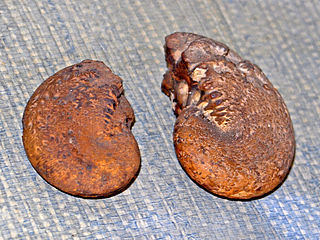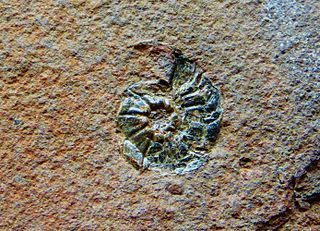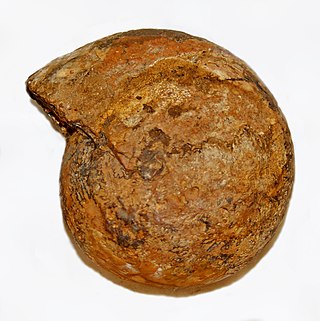Related Research Articles

Ammonoids are extinct spiral shelled cephalopods comprising the subclass Ammonoidea. They are more closely related to living coleoids than they are to shelled nautiloids. The earliest ammonoids appeared during the Devonian, with the last species vanishing during or soon after the Cretaceous–Paleogene extinction event. They are often called ammonites, which is most frequently used for members of the order Ammonitida, the only remaining group of ammonoids from the Jurassic up until their extinction.

The Phylloceratina comprise a suborder of ammonoid cephalopods, belonging to the Ammonitida, whose range extends from the Lower Triassic to the Upper Cretaceous. Shells of the Phylloceratina are generally smooth with small to large umbilici and complex sutures with leaf-like phylloid saddle endings and lobes with thorn-like projections.
Xiphogymnites is an extinct ammonoid cephalopod genus from the Triassic included in the family Gymnitidae. It is known from the Balkans in eastern Europe.

Asklepioceras is a genus in the Ceratitid family Arpaditidae from the Middle and Upper Triassic of Italy, Romania, Turkey, and British Columbia (Canada).

Anolcites is a genus of extinct ammonoid cephalopods from the Middle Triassic belonging to the ceratitid family Trachyceratidae.
Homerites is a genus of small, involute, globase fossil ceratitids with an eccentric outer whorl and subammonitic sutures belonging to the family Halortidae The body chamber has a slight central keel and radial dichotomous ribs that commonly terminate at spines on the ventral shoulder. Homerites, described and named by Mojsisovics in 1893 has been found in the Upper Triassic (Carnian) of California and the Alps. The Halortidae in which it is placed is part of the superfamily Tropitaceae.

Ceratitida is an order that contains almost all ammonoid cephalopod genera from the Triassic as well as ancestral forms from the Upper Permian, the exception being the phylloceratids which gave rise to the great diversity of post-Triassic ammonites.

Prolecanitida is an order of extinct ammonoid cephalopods, the major Late Paleozoic group of ammonoids alongside the order Goniatitida. Prolecanitids had narrow shells, discoidal (disc-shaped) to thinly lenticular (lens-shaped). They retained a retrochoanitic siphuncle, a simple form with septal necks extending backwards. As is typical for ammonoids, the siphuncle sits along the ventral margin of the shell.
Clydonitoidea, formerly Clydonitaceae, is a superfamily in the ammonoid cephalopod order Ceratitida characterized by generally costate and tuberculate shells with smooth, grooved, or keeled venters and sutures that are commonly ceratitic or ammonitic but goniatitic in a few offshoots.
Ceratitoidea, formerly Ceratitaceae, is an ammonite superfamily in order Ceratitida characterized in general by highly ornamented or tuberculate shells with ceratitic sutures that may become goniatitic or ammonitic in some offshoots.

Juraphyllitidae is a family of Lower Triassic phylloceratin ammonites from Europe, North Africa, and Asia characterized by narrow, evolutely coiled shells, usually with coarse ventral ribbing on the body chamber. The first lateral saddles in the suture are diphyllic, with two terminal branches, others exposed sutural saddles are diphyllic or triphyllic, those covered by successive whorls being monophyllic. A few genera are more involute, with successive whorls partially embracing the flanks of the previous. All are compressed and a few lack ribbing.
Lecanites is a ceratitid genus assigned to the Danubitaceae, with an essentially smooth, evolute, discoidal shell and a goniatitic suture with many elements. It is the type and now only genus of the Lecanitidae.
The Danubitoidea is a large and diverse superfamily in the order Ceratitida of the Ammonoidea that combines five families removed from the Ceratitaceae, Clydonitaceae, and Ptychitaceae.
Longobarditidae is a family of ceratitd ammonoids known from the early Triassic, included in the Danubitaceae. Longobarditidae includes genera formerly placed in Hungaritidae by the American Treatise on Invertebrate Paleontology, Part L, 1957 as well as genera that have been described since.
The Haloritidae is a family of subglobular, involute, Triassic ammonoids belonging to the ceratitid superfamily Tropitoidea. Their shells may be smooth or may have ribs that cross or are interrupted on the venter, and may have nodes. Keels and ventral furrows are not typical. The last volution is commonly eccentric. The Suture may be ammonitic, ceratitic, or goniatitic.
Stenopopanoceras is a genus of involute, discoidal ceratitid ammonites from the Middle Triassic that has been found on Spitsbergen and in arctic Russia and British Columbia.
Parapopanoceras is a ceratitid ammonite with a small, smooth, very involute and moderately globose shell that lived during the middle Triassic.

Meekoceras is an extinct genus of ceratitid ammonites with a discoidal shell that lived during the Early Triassic Epoch.
Clypeoceras is a genus of ammonites with an involute discoidal shell from the Lower Triassic.

Halorites is an extinct genus of Triassic ammonoids belonging to the family Haloritidae.
References
- Arkell et al. Mesozoic Ammonoidea; Treatise on Invertebrate Paleontology, Part L, Ammonoidea. Geol Soc of America and Univ Kansas press. R. C. Moore (Ed)
- Classification of E. T. Tozer 1981